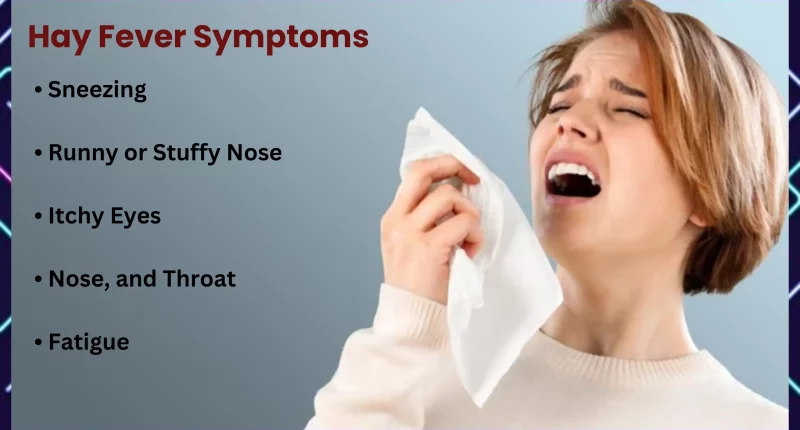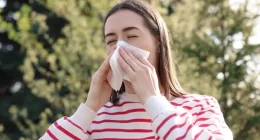Hay fever, also known as allergic rhinitis, is a common condition that affects millions of people worldwide. This allergic reaction occurs when the immune system overreacts to allergens in the environment, such as pollen from trees, grasses, and weeds, as well as mold spores and pet dander. The result is a range of uncomfortable symptoms that can significantly impact daily life.
When examining the prevalence of allergic rhinitis, statistics reveal intriguing insights. Frontiers Clinical and Pathophysiological Overview indicates that approximately 400 million of the global population suffers from allergic rhinitis, with variations based on geographic location and environmental factors.
Interestingly, NHS and Medical News Today report, hay fever affects both genders, but it is often more prevalent in males during childhood. However, by adulthood, the rates tend to equalize, with women experiencing a higher incidence. This gender difference may be attributed to hormonal changes and lifestyle factors.
Symptoms
The symptoms of hay fever can vary in intensity and may include:
- Sneezing: Often the first sign, of sneezing is the body’s attempt to expel allergens.
- Runny or Stuffy Nose: Increased mucus production leads to a runny nose, while inflammation can cause nasal congestion.
- Itchy Eyes, Nose, and Throat: Allergens can irritate sensitive tissues, resulting in discomfort.
- Fatigue: Persistent symptoms can lead to tiredness, affecting overall quality of life.
These symptoms can be triggered by exposure to allergens and may worsen during certain seasons, particularly spring and fall.
The Role Your Immune System Plays
The immune system plays a pivotal role in the development of hay fever. When allergens enter the body, the immune system mistakenly identifies them as harmful invaders. In response, it produces antibodies called Immunoglobulin E (IgE). These antibodies trigger the release of histamines and other chemicals, leading to the classic symptoms of allergic rhinitis. This overreaction is what makes hay fever an allergic condition. Understanding this immune response is vital for developing targeted treatments, such as antihistamines, which can help alleviate symptoms by blocking histamine action.
Common Causes of Hay Fever
allergic rhinitis can be triggered by a variety of allergens. The most common causes include:
- Pollen: Released by trees, grasses, and weeds, pollen is a major seasonal allergen.
- Mold Spores: Mold can thrive in damp environments and release spores into the air.
- Dust Mites: These tiny creatures are found in household dust and can trigger allergic reactions.
- Pet Dander: Proteins found in the skin flakes, urine, and saliva of pets can cause hay fever symptoms.
Clean Tubes and Bulbs Regularly to Prevent Allergic Rhinitis
To effectively prevent hay fever, it is important to establish a regular cleaning schedule for your home. Here are some actionable tips:
- Dust and Vacuum Frequently: Use a vacuum with a HEPA filter to trap allergens effectively.
- Clean Air Filters: Replace or clean air filters in HVAC systems regularly to ensure optimal air quality.
- Wipe Down Surfaces: Use damp cloths to wipe surfaces, which helps capture dust rather than dispersing it into the air.
- Check Light Fixtures: Dust and clean light bulbs and fixtures to help reduce the accumulation of dust, mold, and other allergens that may trigger reactions. Dust and allergens can easily accumulate in these areas, leading to increased exposure when the systems are in use.
By taking these steps, you can significantly reduce allergens in your home, making it a more comfortable space for those affected by allergic rhinitis.
Long-Term Effects of Untreated Hay Fever
The long-term effects of untreated hay fever or common allergic conditions can lead to various complications that extend beyond the immediate discomfort of its symptoms.
Chronic Inflammation and Respiratory Issues – One of the primary long-term effects of untreated hay fever is chronic inflammation of the nasal passages. This persistent inflammation can lead to conditions such as chronic sinusitis, where the sinuses become inflamed and swollen, leading to pain, pressure, and increased susceptibility to infections. Over time, the inflammation can also contribute to the development of asthma, particularly in individuals who already have a predisposition to respiratory issues. Studies indicate that untreated allergies can increase the frequency and severity of asthma attacks, which can be dangerous and even life-threatening in some cases.
Impact on Sleep and Daily Life – Untreated hay fever can severely disrupt sleep patterns due to symptoms like nasal congestion and postnasal drip. Poor sleep quality can lead to fatigue, irritability, and decreased cognitive function, affecting productivity at work or school. Research shows that hay fever contributes to millions of lost work and school days annually, highlighting its impact on daily life and overall well-being.
Psychological Effects – The burden of ongoing symptoms can also lead to psychological effects, including anxiety and depression. The constant discomfort and limitations imposed by hay fever symptoms can diminish quality of life, making it challenging to engage in social activities or enjoy hobbies. Individuals may feel isolated or frustrated by their condition, further exacerbating mental health issues.
Increased Risk of Other Allergies – Another concerning long-term effect is the potential for developing additional allergies. Untreated allergic rhinitis can sensitize the immune system to more allergens over time, leading to more frequent and severe allergic reactions. This can create a cycle where individuals become increasingly reactive to a wider range of allergens, complicating their health profile and management strategies.
Long-Term Health Consequences – In severe cases, untreated hay fever can lead to permanent damage to the lungs. Chronic exposure to allergens and persistent inflammation can diminish lung function, making individuals more susceptible to respiratory diseases and infections. This long-term damage underscores the importance of seeking treatment and managing symptoms effectively to prevent further complications.
How You Can Differentiate Between Hay Fever and Other Allergies
While hay fever and other allergies share some symptoms, several key differences help in distinguishing them:
- Seasonality: Hay fever symptoms are often seasonal, correlating with pollen counts. In contrast, other allergies can be perennial (year-round) or triggered by specific exposures, such as food or dust mites.
- Type of Symptoms: Hay fever primarily affects the nose and eyes, leading to sneezing, nasal congestion, and itchy eyes. Other allergies may cause a broader range of symptoms, including skin rashes, digestive issues, and respiratory distress, depending on the allergen involved.
- Onset of Symptoms: Allergic rhinitis symptoms typically arise shortly after exposure to pollen and can last for weeks or months during peak seasons. Other allergies can produce immediate reactions or delayed responses, depending on the type of allergen and the individual’s sensitivity.
To accurately differentiate between allergic rhinitis and other allergies, medical professionals may recommend:
- Allergy Testing: Skin prick tests or blood tests can identify specific allergens responsible for symptoms, helping to distinguish between allergic rhinitis and other allergic conditions.
- Symptom Tracking: Keeping a diary of symptoms in relation to environmental exposures can help identify patterns that indicate whether the reactions are seasonal (suggestive of allergic rhinitis) or related to specific foods or indoor allergens.
References
- NHS. (2024). Hay fever. https://www.nhs.uk/conditions/hay-fever/
- Medical News Today. (2023). Hay fever (allergic rhinitis): Symptoms, causes, and treatment. https://www.medicalnewstoday.com/articles/160665#treatment
- MDPI. (2023). Allergic Rhinitis Systematic Review Shows the Trends in Prevalence in Children and Adolescents in Greece since 1990. https://www.mdpi.com/2313-5786/3/4/14
- NHS. (2024). Allergic rhinitis. https://www.nhs.uk/conditions/allergic-rhinitis/
- Sinus Health. (2024). What’s the difference between hay fever and allergies? https://sinushealth.com/whats-the-difference-between-hay-fever-and-allergies/
- Nitherapy. (2024). What’s the difference between hay fever and allergies? https://nitherapy.com/whats-the-difference-between-hay-fever-allergies/
- MedicineNet. (2024). Hay fever. https://www.medicinenet.com/hay_fever/article.htm
- BJC. (2024). What untreated allergies could do to your health. https://www.bjc.org/news/what-untreated-allergies-could-do-your-health









